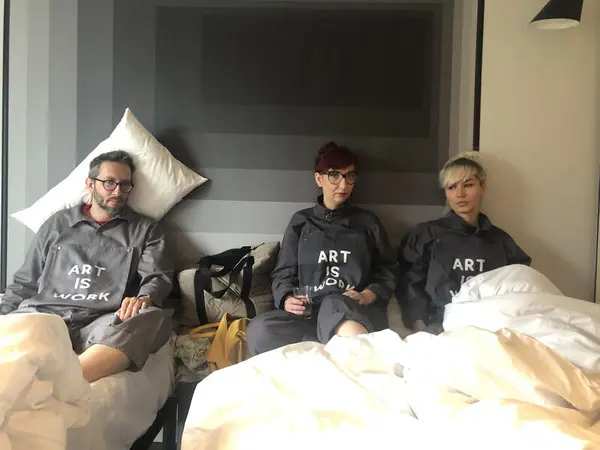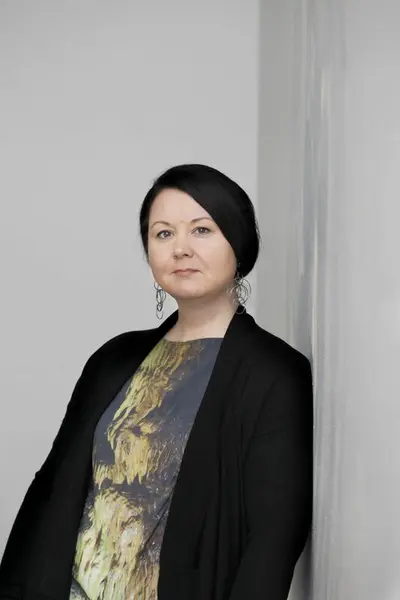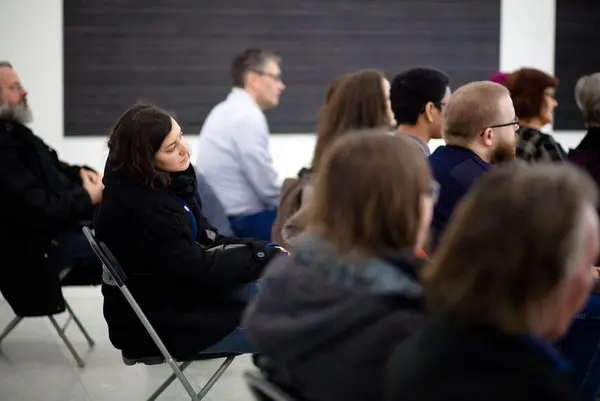At a time when so much of the past and history is being questioned, it is time to reflect on the language and concepts we use, and ask ourselves: do we need a new vocabulary for the museum of the future?
An invitation to a collective discussion and brainstorming: What words should describe the museum of the future?
Trondheim kunst is in the initial phase of a process of possible relocation and merging with Nordenfjeldske Kunstindustrimuseum. In connection with this, the museum uses the opportunity to look at the roles and expectations that shape the relationship between the institution and its audience. The starting point for the seminar is a desire to initiate a performance of a new vocabulary for the museum of the future, a vocabulary that adapts to the needs of both the institution and the general public.
A for accessability C for communication C for community H for health N for necessities O for operation P for play P for politics P for product P for presence P for participation R for repository S for surprise T for trust T for thing T for together V for value Z for zzzzz
Program 25. - 26. November:
Thursday 25. November
13.00 - 13.15
Welcome by Johan Börjesson, director of Trondheim kunstmuseum
13.15 - 14.00
E for Endospore // S for 1:1 Scale // R for Rewilding by Sebastian Cichocki
14.00 - 14.45
N for Network // S for Sharing// P for Proximity // D for by Steffen Wellinger
15.00 - 15.45
Active Residues by Ofri Cnaani
16.30 - 17.30
S for Suprainfinit WORSKHOP/LECTURE PERFORMANCE by Apparatus 22
Friday 26. November
09.30 - 10.00
Introduction by Marianne Zamecznik, curator at Trondheim kunstmuseum
10.00 - 10.45
The Museum of Prefixes: Learning from the Worst-case Scenario by Rasmus Holmboe
11.00 - 11.45
Not-knowing, Rethinking the art museum from pillar to mold by Signe Meisner Christensen
12.00 - 12.30
losing remarks by Kati Kivinen
Museum Why? E for Endospore // S for 1:1 Scale // R for Rewilding
The formats of contemporary art institutions are lumbered with a number of serious shortcomings: exaggeration, extravagance, competitiveness, elitism, overproduction, pomposity and wastefulness. As opposed to this, the practices of artists engaged in generating social change are focused on daily chores, unheroic and unspectacular and not always resulting in a tangible work of art, often escaping the institutional radar; migrating – whether of their own desire or due to necessity – beyond the art world. When dealing with the pitfalls of contemporary art, we must bear in mind the freedom of art, including the freedom to cease being what it is supposed to be. Sometimes this is related to returning to more compromised or historically marginalised forms such as propaganda. After all, every work that persuades us of something, be it a form of aesthetics, an opinion, a pleasure or an unpleasurable experience is a form of propaganda. Today more than ever before, we need the art of propaganda to act on behalf of minority rights, women’s reproductive rights and the well-being of our natural environment and other species. The extravagant costume of contemporary art often constrains movement and impedes the ability to deliver a well-aimed blow.
Museum Why? N for Network // S for Sharing // P for Proximity // D for Distributed
In his talk Steffen Willinger will speculate upon the role of museum spaces in the urban fabric and how the physical presence relate to the multilayered ecosystem of digital, institutional, economic, as well political networks. How can museal spaces of the future develop and support publicness, ecology and societal change?
Museum Why? A for After the Museum (or: Afterness) // C for 'From Collection to Collective'
In six short hours in September 2018 a fatal fire brought to an end two centuries’ worth of treasures in Brazil’s national museum. It seems almost unimaginable that so many valuable objects were simply wiped off the earth without leaving any digital trace. Among the digital remains is a sporadic collection that was contributed by users via WikiCommons and a full virtual tour, a product of Google Arts & Culture, where one can easily visit the no-longer-existing museum. In the absence of a systematic digitization effort at the museum, the fragmented collection that remains poses a challenge to fixed taxonomies and epistemic frameworks, traditionally designed by the state. I use the digital residues to observe the ever-growing sense of hybrid spatiality and to offer methodologies for collective navigation and artistic intervention under the conditions of algorithmic rationality.
Museum Why? S for Suprainfinit
WORKSHOP / LECTURE PERFORMANCE
The artists group Apparatus 22 will present the many ways in which they are engaging in processes of transformation with museums and other types of institutions: from Blank Auguri, a series of immaterial works that come in the shape of names and acts of naming, to POSITIVE TENSION (IN THE AIR) where criticality and celebration collides through a set of questions formulated in response to a specific institutional context, from ART IS WORK uniforms to queer daydreams of works happening outside institutions or as a way of expanding institutions. All of these ventures are imbued with utopian perspectives spanning from the Suprainfinit universe of Apparatus 22.
Museum Why? The Museum of Prefixes: Learning from the Worst-case Scenario
The Museum of Prefixes: Learning from the Worst-case Scenario by Rasmus Holmboe
Recently the critical discourse related to the purposes, operations, and relevance of what we used to know as museums, has included terms such as post-representational, non-exclusive, uncurating, decolonial, intermediary and of course the ever-present idea of rethinking; a series of prefixes by which museums and museum studies are constantly trying to invent themselves anew. Is this to say that the category of the new is dialectical and can only be imagined against the backdrop of the old? While this may seem a reactionary approach to the business of clearing the ground for a new vocabulary, there is still much to be learned from past mistakes. We can only ever fail. And then try again. And then fail. And then try again.
Museum Why? C som i Compos(t)ition
Rethinking the Art Museum from Pillar to Compos(t)ition
Signe Meisner Christensen offers the idea of the museum as not only an assembling device, but also as a plastic device, one that is fundamentally moldable. In shifting the metaphor of the museum from a ‘pillar’ to a ‘compos(t)ition’ she advocates for curating as becoming a central tool in ‘compos(t)ing’ the museum. She will use her own practice-based project OPEN, a public programme at Kunsten, Museum of Modern Art in Aalborg, as an example.
Museum Why? Closing remarks
Kati Kivinen is head curator at Museum of Contemporary Art Kiasma in Helsinki, where she is responsible for the exhibitions, acquisitions and commissions, and research on the museum’s collections.
Participants:

Sebastian Cichocki
Sebastian Cichocki is the chief curator and head of research at the Museum of Modern Art in Warsaw. Selected exhibitions curated and co-curated by Cichocki at the Museum of Modern Art in Warsaw include: ‘Who Will Write the History of Tears. Artists on Women’s Rights’ (2021), ‘The Penumbral Age. Art in the Time of Planetary Change’ (2020), ‘Never Again. Art against War and Fascism in the 20th and 21st centuries’ (2019). Other recent curatorial projects include ‘The Postartistic Congress’, Sokołowsko (2021), ‘Primary Forms’, exhibition at primary schools around Poland (2021), Bródno Biennale, Warsaw (2018). Cichocki also curated the Polish Pavilion at the 52nd and 54th Venice Biennales of Art (in 2007 with Monika Sosnowska, in 2011 with Yael Bartana). He has curated exhibitions in the form of a novella, radio drama, opera libretto, parade, garden, post-growth residency programme, and performance lectures. Cichocki is one of the founding members of The Consortium for Postartistic Practices and The Office for Postartistic Services. He is a 2018 fellow at the Center for Curatorial Leadership, MoMA, New York..

Steffen Wellinger
Steffen Wellinger is professor in architecture at the Department of architecture and planning at NTNU in Trondheim/Norway. He is interested in the reciprocal relation of sustainability, health and beauty in architecture. His educational activities and research are mainly focused on the public realm and public buildings. Steffen is as well coordinating the NTNU Live Studio where students carry out co-curricular activities such as strategic urban interventions. NTNU Live Studio has in 2015 received the Norwegian Education Award.

Ofri Cnaani
Ofri Cnaani is an artist. She works in time-based media, performances, and installations. Her work appeared at Tate Britain, UK; Metropolitan Museum of Art, NYC; Venice's Architecture Biennale; Inhotim Institute, Brazil; PS1/MoMA, NYC; BMW Guggenheim Lab, NYC; Kunsthalle Wien, Vienna. Cnaani is a PhD researcher and Associate Lecturer at the Visual Cultures Department, Goldsmiths, UoL.

Apparatus 22
Apparatus 22 is a transdisciplinary art collective founded in January 2011 by current members Erika Olea, Maria Farcas, Dragos Olea together with Ioana Nemes (1979 - 2011) in Bucharest, Romania. Beginning with 2015 they are working between Bucharest, Brussels and Suprainfinit (utopian universe). They see themselves as a collective of daydreamers, citizens of many realms, researchers, poetic activists and (failed) futurologists interested in exploring the intricate relationships between economy, politics, gender studies, social movements, religion and fashion in order to understand contemporary society. Queering and touching the imagination of people are at centre of their art practice. Starting with 2015 a major topic of research and reflection for Apparatus 22 is SUPRAINFINIT utopian universe: a world-making attempt to use hope critically in navigating present and future. In their very diverse works - installations, performances, text based-shapes, reality is mixed with fiction and storytelling and all merge with a critical approach drawing knowledge & experience from design, sociology, literature and economics.

Rasmus Holmboe
Rasmus Holmboe is postdoc at the research centre Art as Forum at University of Copenhagen, where he works on a project with the Museum of Contemporary Art in Roskilde under the title The Distributed Art Museum. His work traverses the fields of curating, sound studies, art history, musicology and museology with a strong interest in the social and political infrastructures and institutions of the art world. PhD (2019) with the dissertation The Resonant Museum: Sound, Art and the Politics of Curating.

Signe Meisner Christensen
Signe Meisner Christensen is a curator and art researcher based in Aarhus. She works in-between curating, art-based research, and combines academic and collaborative, transdisciplinary work. Her research, which is often practice-based, focuses on the methods and the experiential formats through which curatorial inquiry articulates itself. She approached curatorial action as a making practice that collaborates to enable ecosystems and shared worlds to grow. She holds a PhD in contemporary curating from Aarhus University and presently teaches at Urban Design and Art and Technology, Aalborg University. Recent publications include co-editing the volume “New Infrastructures, Performative Infrastructures in the Art Field”, special issue of Passepartout.

Kati Kivinen
Kati Kivinen is head curator at Museum of Contemporary Art Kiasma in Helsinki, where she is responsible for the exhibitions, acquisitions and commissions, and research on the museum’s collections. Her recent curatorial projects there include group exhibitions: Mad Love: The Seppo Fränti Collection at Kiasma (2020); Coexistence: Human, Animal and Nature in Kiasma’s Collections, Kiasma, Helsinki (2019); There and Back Again: Contemporary Art from the Baltic Sea Region, Kiasma, Helsinki (2018); and solo exhibitions of Mika Vainio: 50 Hz (2020). She worked as Artistic Director of AV-arkki - The Centre for Finnish Media Art, where she curated a number of screening programs (2009-2010).
- 1/1
Museum Why? is an network consisting of Trondheim kunstmusuem, Malmö Art Museum (SE), Nykytaiteen museo Kiasma (FI) Museum of Contemporary Art Kiasma og Kunsten som Forum Forskingscenter (DK).
